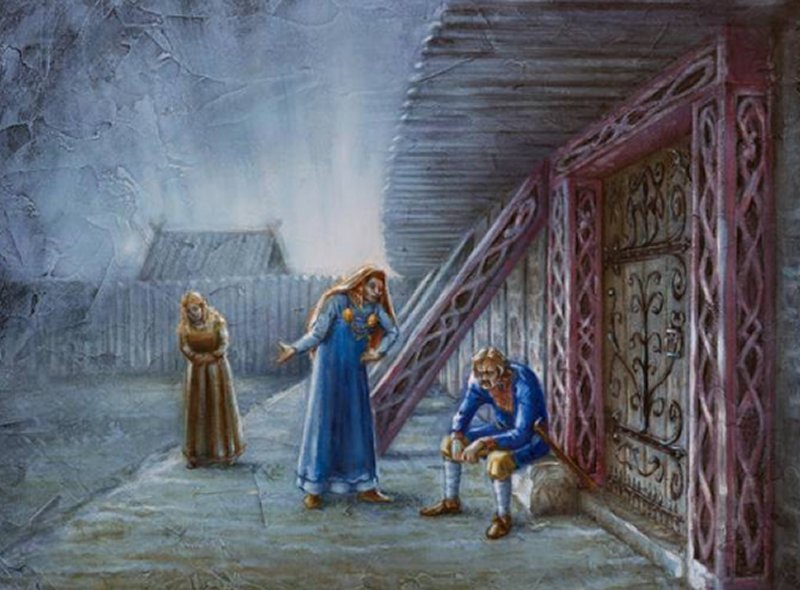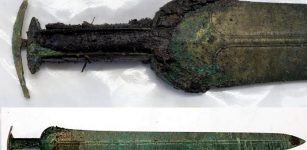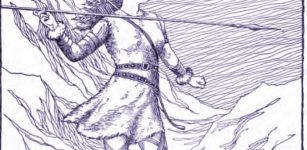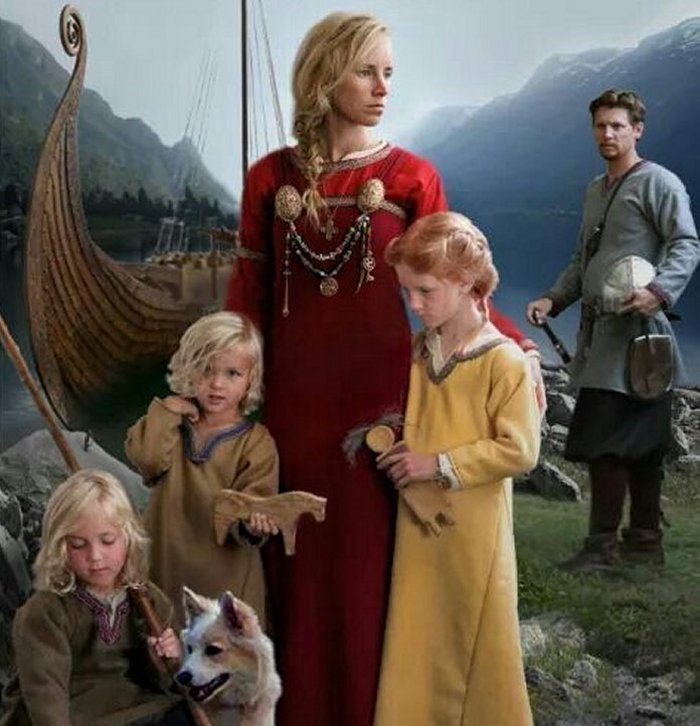Mother, Father, Child, Marriage And Divorce In Viking Society
A. Sutherland - AncientPages.com - The Vikings lived in large families that included parents, children, and grandparents. When the eldest son took over the estate, he became head of his family and from now on he had responsibility for the welfare of all.
He must provide the family with food and his wife, who was in charge of the house had to make butter and cheese, dry and smoke fish, and prepare food storage that would be enough for everyone during the long dark winter.
 Viking life. Image credit: Mats Vänehem
Viking life. Image credit: Mats Vänehem
Additionally, she was also expected to have knowledge of herbs to prepare medicine for the sick and wounded.
Also, the responsibility for pets and farm animals rested on her and when the man went on trade trips, hunted, or walked in the Viking (meant to disappear away for a long period), it was his wife who was responsible for almost everything at home and managed the whole farm. The women were praised for their extraordinary home-running skills and artistic abilities. They were the ones who took care of all the farm and possessions.
In wealthy families, a woman had servants to help her, so it was much easier.
Time To Get Married
There is not much knowledge about the Viking wedding ritual itself, but certain indications from myths and traditions that followed from the Viking Age shed some light on the subject. Usually, the wedding was a party with relatives and friends that lasted for several days.
Viking boys and girls got married very early. Girls were usually married when they were between 12 and 15 years old and were then expected to manage a household, which certainly wasn’t always very easy. Hopefully, they could get some help from the adult women in the family.
After all, these Viking girls were still children, but they learned from their mothers and grandmothers how to keep run the household properly, to cook, clean, prepare meals, make yarn and weave and sew. Girls were also taught farm work and tending animals as it was their duty to run a farm when the men were away.
The marriage, which was planned by the relatives, was seen as a covenant for happening assistance and protection. The law did not require the consent of the woman at marriage and the girl herself had not much to say in the matter.
However, according to ancient oral tradition, it was common for fathers to discuss the subject with their daughters.
The Woman’s Dowry Was Her Personal Property
The bride brought cloth of linen and wool, a loom, and a bed as part of her dowry. The women from richer families were also able to bring with them jewelry made of silver and gold, pets, and even farms as part of the dowry.
Everything she brought into the marriage continued to be her personal property and was later passed on as a mother’s inheritance to her child.
Divorce Was Sometimes Necessary
According to Viking tradition, a woman continued throughout her life to be part of her own family and thus never completely became part of her husband's family.
If a husband treated his woman or the children badly, was too lazy to be able to provide for them, or offended her family, she could divorce him. Women could ask for a divorce at the ‘Thing’ (tinget), although this did not happen very often. However, Viking women had always had the right to divorce if they wanted to.
To carry out the divorce, the woman just needed to summon a few people who could be witnesses. At first, they gathered at the front door of the house, then, at the couple's bed, and then, she declared herself divorced from her husband. If a woman left her husband without a valid reason, the husband was allowed to keep her property.
Children Were Protected By The Law
Toddlers and young children automatically stayed with the mother in the event of a divorce. Older children, on the other hand, were usually divided between parents according to the wealth and status of each Viking family.
In the Viking family, children were protected by the law, which gave them the right to obtain their inheritance even after a divorce of their parents.
Not All Vikings Were Wealthy
In the smaller farms, the division between the work of women and men was not so clearly seen. Such a married couple had no servants, and therefore, all members of the family must do their best for the survival of their family, in the cold climate of Nordic countries.
Written by – A. Sutherland - AncientPages.com Senior Staff Writer
Copyright © AncientPages.com All rights reserved. This material may not be published, broadcast, rewritten or redistributed in whole or part without the express written permission of AncientPages.com
More From Ancient Pages
-
 Drought Was Not The Reason Cahokia, North America’s First City Was Suddenly Abandoned – New Study
Archaeology | Jul 4, 2024
Drought Was Not The Reason Cahokia, North America’s First City Was Suddenly Abandoned – New Study
Archaeology | Jul 4, 2024 -
 Did Etruscans Solve The Mystery Of Synchronicity And The Secret Language Of The Stars?
Ancient Mysteries | Jul 5, 2018
Did Etruscans Solve The Mystery Of Synchronicity And The Secret Language Of The Stars?
Ancient Mysteries | Jul 5, 2018 -
 Mysterious Mohenjo Daro Was Home To An Unknown Advanced Civilization Far Ahead Of Its Time
Civilizations | Apr 2, 2014
Mysterious Mohenjo Daro Was Home To An Unknown Advanced Civilization Far Ahead Of Its Time
Civilizations | Apr 2, 2014 -
 Archaeologists Survey Bronze Age Konar Sandal Site In Southeast Iran
Archaeology | Feb 17, 2021
Archaeologists Survey Bronze Age Konar Sandal Site In Southeast Iran
Archaeology | Feb 17, 2021 -
 A 1.3 kg Heavy Bronze Sword Unearthed On Funen Island, Denmark
Archaeology | Mar 16, 2021
A 1.3 kg Heavy Bronze Sword Unearthed On Funen Island, Denmark
Archaeology | Mar 16, 2021 -
 Hamingja – Norse Guardian Spirit Bringing Good Luck From Generation To Generation
Myths & Legends | May 20, 2024
Hamingja – Norse Guardian Spirit Bringing Good Luck From Generation To Generation
Myths & Legends | May 20, 2024 -
 2,500-Year-Old Large Untouched Scythian Burial Ground Unearthed In Khakassia, Siberia
Archaeology | Oct 6, 2020
2,500-Year-Old Large Untouched Scythian Burial Ground Unearthed In Khakassia, Siberia
Archaeology | Oct 6, 2020 -
 Skadi: Goddess Of Destruction, Giantess And Patron Of Winter Hunters And Skiers In Norse Mythology
Featured Stories | Dec 14, 2017
Skadi: Goddess Of Destruction, Giantess And Patron Of Winter Hunters And Skiers In Norse Mythology
Featured Stories | Dec 14, 2017 -
 Girl’s Ancient Tooth Solves One Of The Biggest Mysteries Of The Denisovans
Archaeology | May 17, 2022
Girl’s Ancient Tooth Solves One Of The Biggest Mysteries Of The Denisovans
Archaeology | May 17, 2022 -
 Advanced Ancient Technology – Talos A Greek Robot Created By The God Of The Forge
Featured Stories | Jun 28, 2014
Advanced Ancient Technology – Talos A Greek Robot Created By The God Of The Forge
Featured Stories | Jun 28, 2014 -
 3D Scans Used To Study Mysterious Roman Burial Practice
Archaeology | Jun 5, 2023
3D Scans Used To Study Mysterious Roman Burial Practice
Archaeology | Jun 5, 2023 -
 Ming-Era Two Shipwrecks With 100,000 Ancient Relics Examined By Scientists
Archaeology | May 30, 2023
Ming-Era Two Shipwrecks With 100,000 Ancient Relics Examined By Scientists
Archaeology | May 30, 2023 -
 Mysterious Ancient Tomb Reveals ‘Impossible’ Human Connection To Cosmos – Human Anomaly? – Part 2
Ancient Mysteries | Oct 15, 2020
Mysterious Ancient Tomb Reveals ‘Impossible’ Human Connection To Cosmos – Human Anomaly? – Part 2
Ancient Mysteries | Oct 15, 2020 -
 Denisovan Genetic Heritage Could Affect The Mental Health Of European And Asian Populations
DNA | Oct 31, 2023
Denisovan Genetic Heritage Could Affect The Mental Health Of European And Asian Populations
DNA | Oct 31, 2023 -
 Viking Grave And Sword Discovered In Norwegian Garden
Archaeology | Jul 3, 2023
Viking Grave And Sword Discovered In Norwegian Garden
Archaeology | Jul 3, 2023 -
 Tiny Paper Scraps From ‘Queen Anne’s Revenge’ Shed Light On Reading Habits Of Blackbeard’s Pirates
Archaeology | Jan 7, 2018
Tiny Paper Scraps From ‘Queen Anne’s Revenge’ Shed Light On Reading Habits Of Blackbeard’s Pirates
Archaeology | Jan 7, 2018 -
 Recent Unexpected Findings Of Early Sweet Potato Cultivation In Polynesia
Archaeology | Oct 2, 2024
Recent Unexpected Findings Of Early Sweet Potato Cultivation In Polynesia
Archaeology | Oct 2, 2024 -
 2000 Ancient Gold Spirals Used By Sun-Worshiping Priest-Kings During The Bronze Age Discovered In Denmark
Archaeology | Jul 9, 2015
2000 Ancient Gold Spirals Used By Sun-Worshiping Priest-Kings During The Bronze Age Discovered In Denmark
Archaeology | Jul 9, 2015 -
 King Sanakht: Mysterious Ancient Egyptian Pharaoh Was A ‘Giant’ – Scientists Say
Archaeology | Aug 9, 2017
King Sanakht: Mysterious Ancient Egyptian Pharaoh Was A ‘Giant’ – Scientists Say
Archaeology | Aug 9, 2017 -
 Cyrus The Great Cylinder – Legacy Of The Ancients
Artifacts | Aug 25, 2015
Cyrus The Great Cylinder – Legacy Of The Ancients
Artifacts | Aug 25, 2015

